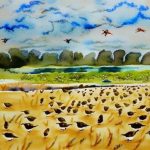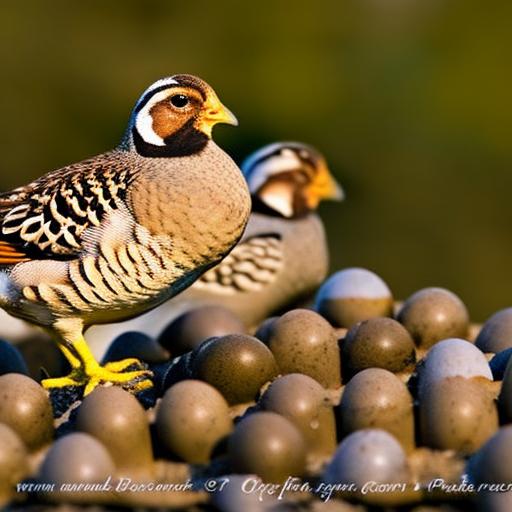Quail breeding season is a crucial time for these small game birds. It is during this time that quails engage in courtship rituals and mating behaviors, leading to the production of offspring. The breeding season typically occurs in the spring and early summer months when the weather is warmer and food sources are more abundant. During this time, male quails become more vocal, using their distinct calls to attract females and establish their territories. Female quails also become more receptive to mating, signaling their readiness through specific behaviors and vocalizations.
Quail breeding season is essential for the continuation of the species, as it is the time when new generations of quails are produced. Understanding the breeding season is crucial for anyone involved in quail management, whether for conservation, hunting, or agricultural purposes. By understanding the natural behaviors and rhythms of quails during the breeding season, individuals can better support and encourage successful breeding outcomes for these birds.
Table of Contents
Key Takeaways
- Quail breeding season typically occurs in the spring and summer months when the weather is warmer and food is more abundant.
- Factors such as temperature, daylight length, and food availability can affect the timing and success of quail breeding season.
- Signs of quail breeding season include increased vocalization, courtship behavior, and the presence of nesting sites.
- Best practices for quail breeding season include providing suitable habitat, managing predators, and minimizing disturbances to nesting areas.
- Tips for encouraging quail breeding include planting native vegetation, providing water sources, and creating brush piles for cover.
- Challenges of quail breeding season may include habitat loss, predation, and extreme weather events.
- Making the most of quail breeding season involves proactive habitat management, predator control, and monitoring population trends to ensure the long-term success of quail breeding efforts.
Factors Affecting Quail Breeding Season
Several factors can influence the quail breeding season, impacting the timing and success of mating and reproduction. One of the most significant factors is environmental conditions, including temperature, rainfall, and habitat quality. Warmer temperatures and adequate rainfall can lead to an increase in food availability, which is essential for supporting healthy quail populations during the breeding season. Additionally, suitable habitat with adequate cover and nesting sites can significantly impact the breeding success of quails.
Another critical factor affecting the quail breeding season is predator pressure. High predation rates can disrupt quail mating behaviors and nesting efforts, leading to lower reproductive success. Managing predator populations and implementing predator control measures can help mitigate this factor and support successful quail breeding outcomes.
Furthermore, population dynamics within quail communities can also influence the breeding season. Competition for mates, territory, and resources can impact the ability of individual quails to successfully breed. Understanding these factors and their potential impacts on the breeding season is essential for effectively managing quail populations and promoting successful reproduction.
Signs of Quail Breeding Season
During the quail breeding season, several signs indicate that these birds are actively engaged in mating behaviors and reproduction. One of the most noticeable signs is the increased vocalization of male quails. Male quails use their distinct calls to attract females and establish their territories, creating a cacophony of sound in suitable quail habitats.
Another sign of the breeding season is the courtship displays and behaviors exhibited by male and female quails. Males may engage in elaborate strutting displays, puffing up their feathers, and performing intricate dances to attract females. Female quails, on the other hand, may exhibit specific behaviors to signal their readiness to mate, such as crouching low to the ground or engaging in reciprocal calls with males.
Nesting activities also indicate the onset of the breeding season, as female quails search for suitable sites to build their nests and lay their eggs. Finding quail nests or observing nesting behaviors can provide valuable insights into the timing and progression of the breeding season. By recognizing these signs, individuals can better understand when quails are actively breeding and take appropriate measures to support their reproductive efforts.
Best Practices for Quail Breeding Season
To support successful quail breeding during the breeding season, several best practices can be implemented. One essential practice is habitat management, ensuring that quails have access to suitable nesting sites, cover, and food sources. Maintaining diverse vegetation types, including grasslands, shrubs, and woody cover, can provide quails with the necessary resources for successful reproduction.
Another best practice is predator management, which involves implementing strategies to reduce predation pressure on quail populations. This may include controlling predator populations through trapping or hunting, as well as modifying habitat to create safer nesting environments for quails.
Additionally, providing supplemental food and water sources during the breeding season can support quails by ensuring they have access to essential nutrients and hydration. This can be particularly beneficial during periods of drought or food scarcity when natural resources may be limited.
Furthermore, minimizing disturbances in quail habitats during the breeding season is crucial for reducing stress on nesting birds and promoting successful reproduction. This may involve limiting human activities such as construction, recreational use, or other disturbances that could disrupt quail mating behaviors and nesting efforts.
Tips for Encouraging Quail Breeding
In addition to best practices, there are several specific tips for encouraging quail breeding during the breeding season. One tip is to create brush piles and other forms of cover within quail habitats to provide nesting sites and protection for quails during the breeding season. These structures can offer shelter from predators and inclement weather, as well as serve as safe locations for nesting activities.
Another tip is to implement prescribed burning as a habitat management tool to promote new growth and improve habitat quality for quails. Controlled burns can stimulate the growth of native grasses and forbs, creating ideal conditions for nesting and brood-rearing.
Providing supplemental water sources such as small ponds or strategically placed water troughs can also encourage quail breeding by ensuring that birds have access to essential hydration during the breeding season.
Furthermore, creating corridors and connectivity between suitable quail habitats can facilitate movement and dispersal of quail populations, promoting genetic diversity and increasing breeding opportunities for these birds.
Challenges of Quail Breeding Season

Despite efforts to support quail breeding during the breeding season, several challenges can impact reproductive success. One significant challenge is habitat loss and fragmentation, which can limit the availability of suitable nesting sites and reduce overall habitat quality for quails. Addressing these challenges may require habitat restoration efforts and landscape-scale conservation initiatives to create interconnected habitats for quail populations.
Another challenge is the presence of invasive species that can outcompete native vegetation and alter habitat structure, impacting the ability of quails to find suitable nesting sites and food sources during the breeding season. Managing invasive species through targeted control measures is essential for mitigating this challenge and supporting successful quail reproduction.
Additionally, climate variability and extreme weather events can pose challenges for quail breeding, affecting food availability, nesting success, and chick survival. Adapting management strategies to account for these challenges may involve implementing supplemental feeding programs or adjusting habitat management practices to mitigate the impacts of climate-related stressors on quail populations.
Furthermore, addressing predation pressure from native and non-native predators remains a persistent challenge during the breeding season. Implementing effective predator management strategies while maintaining ecological balance is crucial for supporting successful quail breeding outcomes.
Making the Most of Quail Breeding Season
The quail breeding season is a critical period for these small game birds, representing a time of heightened reproductive activity and the production of new generations. Understanding the factors influencing the breeding season, recognizing signs of active mating behaviors, and implementing best practices and tips for supporting quail breeding are essential for promoting successful reproduction.
By addressing challenges such as habitat loss, invasive species, climate variability, and predation pressure, individuals can work towards creating favorable conditions for quails during the breeding season. Through proactive management efforts that prioritize habitat quality, predator control, and supportive interventions, it is possible to make the most of the quail breeding season and contribute to the conservation and sustainability of these iconic game birds.
If you’re interested in learning about the breeding season of quails, you might also want to check out this insightful article on when is duck mating season. Understanding the mating seasons of different poultry can be crucial for successful breeding and raising healthy flocks.
FAQs
What is the breeding season for quail?
The breeding season for quail typically occurs in the spring and early summer months, usually from April to June.
How do quail breed during their breeding season?
During the breeding season, male quail will perform courtship displays to attract females. Once a female is chosen, they will mate and the female will lay eggs in a nest on the ground.
How many eggs do quail lay during the breeding season?
Quail can lay anywhere from 12 to 16 eggs in a single clutch during the breeding season.
How long does the breeding season last for quail?
The breeding season for quail typically lasts for a few months, with peak breeding activity occurring in the spring and early summer.
What factors can affect the breeding season for quail?
Factors such as temperature, food availability, and habitat conditions can all affect the timing and success of the breeding season for quail.
Meet Walter, the feathered-friend fanatic of Florida! Nestled in the sunshine state, Walter struts through life with his feathered companions, clucking his way to happiness. With a coop that’s fancier than a five-star hotel, he’s the Don Juan of the chicken world. When he’s not teaching his hens to do the cha-cha, you’ll find him in a heated debate with his prized rooster, Sir Clucks-a-Lot. Walter’s poultry passion is no yolk; he’s the sunny-side-up guy you never knew you needed in your flock of friends!







